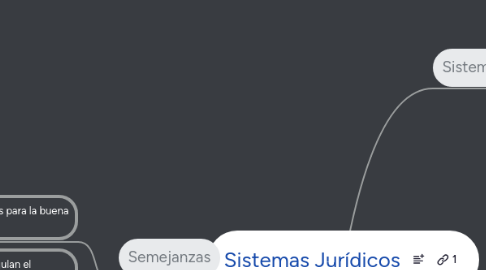
1. Semejanzas
1.1. Considera los delitos nocivos para la buena convivencia social
1.2. Contemplan normas que regulan el matrimonio, la filiación y la herencia, estructuras fundamentales de la propiedad familiar
2. Sistema Jurídico religioso Musulmán
2.1. Sistema autónomo de derecho religioso propiamente dicho cuya base es el Corán
2.2. El Derecho Musulmán ha sido el fundamento y el factor más dinámico para la consolidación del orden social y de la vida comunitaria de los pueblos musulmanes
2.3. Las principales fuentes del Derecho Musulmán son:
2.3.1. El Corán o Libro Sagrado del Islam
2.3.2. La Sunna o tradición relativa al enviado de Dios
2.3.3. El Ichmaa o consentimiento universal de la comunidad musulmana
2.3.4. El Qiyás o razonamiento por analogía
2.4. Su Fundador es Mahoma
2.5. El Derecho Penal Islámico, dado su carácter religioso no hace una distinción entre pecado y delito, los delitos penales se pueden dividir en tres categorías: delitos de sangre, delitos contra la religión y delitos nocivos para la buena convivencia social
3. Sistema Jurídico mexicano
3.1. Su origen es en el Sistema Jurídico Neorromanista
3.1.1. Situational Analysis / Drivers
3.1.1.1. What is driving us to do this?
3.1.1.2. SWOT Analysis
3.1.1.2.1. Strengths
3.1.1.2.2. Weaknesses
3.1.1.2.3. Opportunities
3.1.1.2.4. Threats
3.1.1.3. Customer Findings - What have we learned from customers?
3.1.2. Competitive Analysis
3.1.2.1. Do we have competitors and threats in these target markets with the proposed offerings?
3.1.2.2. What are our competitors doing and how are they positioning?
3.1.2.3. How do we position against each competitor?
3.1.3. Target Customer(s)
3.1.3.1. Buyer Profile
3.1.3.1.1. Title
3.1.3.1.2. Industry
3.1.3.1.3. Geography
3.1.3.1.4. Business Size
3.1.3.2. Influencer Profile
3.1.3.3. User Profile
3.1.3.4. What do customers want and need?
3.1.3.5. What business problems do each of these customers have?
3.1.4. Customer Segmentation
3.1.4.1. Which customers or sets of customers do we sell to?
3.1.4.2. What are the target market segments that we want to go after?
3.1.4.3. What are the distinct problems for each segment of the market?
3.1.5. Total Available Market
3.1.5.1. New Prospects
3.1.5.1.1. How much of each target segment have we penetrated?
3.1.5.1.2. How much opportunity is available in each target segment?
3.1.5.2. Existing Customers
3.1.5.2.1. Can we up-sell existing customers?
3.2. Se formo en la civilización Roma y con mucho éxito pues en su formación como en su re implmentación duró unos catorce siglos
3.2.1. Service Offer
3.2.1.1. What are we selling?
3.2.1.2. Product Definition
3.2.1.3. Pricing
3.2.1.4. Packaging
3.2.1.5. Positioning
3.2.2. Value Proposition
3.2.2.1. What is the Value Proposition to the Customer?
3.2.2.2. What pain are we solving?
3.3. Es importante su estudio para el estudiante de Derecho pues, un sin número de instituciones gestadas en aquella época siguen vigentes y funcionando casi sin alteraciones en su forma hasta hoy
3.3.1. Revenue Forecasts
3.3.1.1. Revenue and P&L Forecast (5 Years)
3.3.1.2. Revenue should be split out quarterly
3.3.2. Cost Analysis
3.3.2.1. Should include a description of the costs in entering this business and profitability analysis
3.3.3. Profitability Analysis
3.3.3.1. P&L for the offer to include gross margin, net income and break even analysis.
3.4. Sus elementos son:
3.4.1. Las Fuentes del Derecho
3.4.1.1. Direct Sales Strategy
3.4.1.2. Inside Sales Strategy
3.4.1.3. Channel Sales Strategy
3.4.2. La finalidad de la Norma Jurídica
3.4.2.1. Channel Strategy
3.4.2.1.1. What 3rd party channels should we consider for reselling this service?
3.4.2.2. Technology Partnerships
3.4.2.2.1. What technology vendors (if any) do we need to work with to execute on this plan?
3.4.2.3. Solutions Partners
3.4.3. La Codificación del Derecho
3.4.4. El proceso de creación de la Norma
3.4.5. La Clasificación del Derecho y la Función Judicial

